< Previous | Contents | Next >
We may wish it had been possible, in the replanning of this heart of the town, to open up the view of the castle on the rock from the great square. It would have been one of the finest spectacles in the heart of any city. As it is, the castle is but a stone's throw or two up a street off the square, so that we step from the City Centre to the Castle Rock in a very few minutes. One of Nottingham's rare sights is at the entrance gateway to the castle, with banked lawns like velvet, rockeries and trees climbing to the terrace, and delightful flower beds.
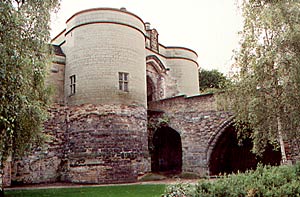
Nottingham Castle gatehouse in 2001.
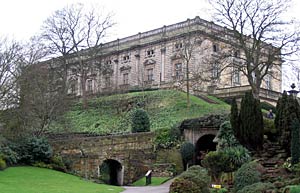
The 'Ducal Palace' in 2004.
The magnificent view from the terrace is like the view from the Council House, save that the dome is in the foreground of the castle's picture of the city rising to the hills. On one of the lawns beyond the medieval gatehouse (looking almost new with restoration) is Nottingham's memorial to Albert Ball, VC, the gallant airman who accounted for about 50 enemy aircraft, and was killed in action three months after receiving the freedom of Nottingham when he was only 20. His bronze figure stands on a stone pedestal, dressed in flying kit and looking upwards, while the bronze figure of a woman, gracefully poised behind him, is pointing to the sky. On another lawn stands an obelisk in memory of men who fell in the Afghan War, and there is a bronze bust of Jonathan White, a Nottingham soldier who won distinction in India. By a broad path is part of an old bastion of the old castle wall, and here also is a lead cistern of 1681. At the end of a path leading to the inner moat is a square block, built up with original stones of the town wall which came to light when the Great Central railway was being laid through Nottingham, and facing it stands a Georgian doorway. An old stone archway leads into the moat, now a charming walk and bowered with trees, from which rustic paths wind up the steep bank to the castle. An interesting relic in the moat is a great oak beam taken from a pier of a 17th century bridge over the Trent at Cromwell near Newark. It was found in the river bed some years ago.
Down a 17th century brick stairway from the terrace we may reach the medieval dungeons which the Duke of Newcastle used as his wine cellar, and there is a vivid reminder of olden days in Mortimer's Hole, a passage with golden walls which winds through the rock from the height of the terrace down to Castle Boulevard; it is lit up for us today and has been made more roomy, but we may see the original spiral stairs at the top. It is thrilling to stand on Castle Boulevard and see the massive side of the rock through which this passage runs.
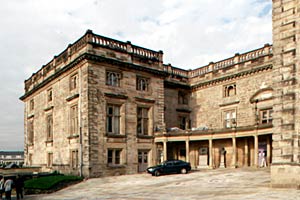
Entrance to Nottingham Castle in 2001.
We enter the castle under a crescent colonnade, where is an array of bronze memorials of renowned poets. Here is Albert Toft's bust of Philip James Bailey, with a plaque on the pedestal showing Festus. Oliver Sheppard's bust of Henry Kirke White has on the pedestal a bowed woman holding a spray of laurel. George Frampton's busts of William and Mary Howitt are delightful; Mary's cap is tied under her chin, and her arm is round William's shoulder, both looking at an open book. Byron's bust is by Alfred Drury. There are two sculptured panels by Ernest Gillick, one showing Thomas Miller, the basket-maker's apprentice who wrote Songs of the Sea-nymphs, the other showing Robert Millhouse with his quill pen; he was the weaver-poet who worked a stocking-frame when he was ten, sang in the choir of St Peter's Church, and lies in the General Cemetery here.
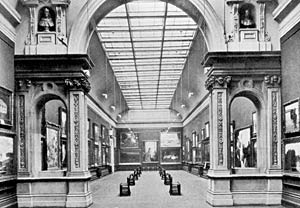
The Long Gallery, Nottingham Castle Art Museum in the late 1930s.
In the castle is one of the rarest miscellaneous art collections in the kingdom. Nottingham's own group of poets and artists and historic folk is well represented. We see Colonel Hutchinson in his wig and armour, Charles Stuart, Albert Ball, William Booth, Richard Arkwright, Philip James Bailey, William Howitt, and Dr Thoroton, the county historian, by Sir Godfrey Kneller. There is a portrait of Kirke White by Hoppner, a portrait of Richard Parkes Bonington by himself and another by Thomas Philips, and a portrait of Samuel William Oscroft, a local painter and collector who bequeathed much of his collection to this museum. Three of Richard Bonington's pictures here are his famous Fisher Folk on the Coast of Normandy, the Coast Scene, and the Undercliff, a dainty little picture covering only 40 inches. On the back of it is written : "The last drawing made by our dear son prior to his fatal dissolution; never to be parted with." He was born in the beginning of last century and lived barely 27 years, bequeathing the rich treasure which Nottingham shares with the Wallace Collection. There are some of his fine pencil sketches in this museum.
Other notable pictures here are Laura Knight's On the Sands, and Motherhood; Arnesby Brown's Full Summer, and Tom Browne's Old Cronies, all these being Nottingham artists. Thomas Sandby and his brother Paul, founder members of the Royal Academy, were also Nottingham artists, and here hang two of Thomas Sandby's works, one of the Colonnade at Covent Garden. Here is Richard Wilson's picture of Snowdon, George Morland's portrait of himself and his man cooking a sausage, the Major Oak of Sherwood Forest by MacCallum, and John Laslett Pott's picture of Mary Queen of Scots being led to execution.
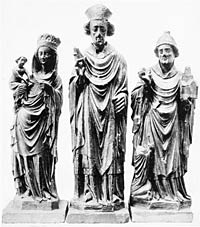
Alabaster figures from Flawford.
The rare examples of alabaster sculpture here are attributed to the Nottingham carvers who made this work famous in medieval days, when most of the alabaster came from Chellaston, being fashioned by them for churches and great houses throughout the land and on the continent. The quarries they used are busy again today yielding gypsum for plaster of paris. One of the alabasters here is the Crucifixion, with the two thieves; on it are 20 figures and two horses. Another is the Entombment, and there is a quaint Resurrection scene with three soldiers asleep and one watching Christ rising from the tomb. In a fine piece about 20 inches high the patron saint of metal workers is shoeing a horse said to be possessed of the devil, and has taken off the horse's leg in order to do the work more easily. Three beautifully draped figures have won more than local fame since they were found in 1779 on the site of the destroyed church of the lost village of Flawforth, between Edwalton and Ruddington. Known as the Flawforth figures, they are a smiling Madonna, wearing a crown, Peter holding a church, and a bishop giving blessing.
The museum has much beautiful Nottingham ironwork. There are the lovely gates from Colwick Hall, the garden screen from old Plumptre House, the railings from Bramcote Manor House, and an old sign with the date 1752 cleverly worked in with the hammer, horseshoe, and pincers of a smithy. One of Nottingham's famous smiths was Huntingdon Shaw. Here also are shown such things as an iron-studded doorway from an old lane in Nottingham, some ornamental leadwork, and carved oak pillars from an Elizabethan colonnade round the old marketplace.
In the collection of old porcelain are examples of most of the famous wares, and there are two cups, a saucer, and a plate of the now rare Pinxton porcelain, in apple green and amethyst. A jug in Derby china of 1782 has the head of Admiral Rodney for its spout. The collection of Wedgwood left to the city by Mr Felix Joseph is the finest in England, with rare cups, teapots, plaques, medallions, vases, dainty little figures and black busts of Byron, Addison, Ben Jonson, Milton, and Rousseau. There is a famous vase of the Apotheosis of Homer designed by Flaxman, and a copy of the famous Portland Vase. With the local pottery of salt-glazed ware is a stout 15th century jug found during excavations, and a great jug of Chesterfield ware decorated with hunting scenes and classical subjects, the neck being fashioned of vines and the spout shaped into the head of Bacchus.
There is a splendid collection of coins of all ages, among them medieval medals and tokens of Nottingham merchants. There is the mummy of a baby among the Egyptian antiquities, and among the Roman relics a head of Julius Caesar, a bust of Jupiter, and the portrait bust of a Roman lady said to be among the finest of its kind; she has her hair bunched up in a quaint plait at the top of her head.
Among other ancient treasures here are two British canoes found not long ago in the River Trent near Clifton Grove, and thought to be over 2000 years old. Hundreds of piles found driven into the bed of the river are thought to have supported a group of huts about 400 BC.
The old kitchen of the castle, where we can still see the ovens in which bread and cakes were baked in the 17th century, are now the textile gallery, packed with interesting and beautiful things. Chinese and Persian embroideries arrest us on the stairs as we go down. There is a Chinese banner of gold thread and pearls, and a fine reproduction of the famous Bayeux tapestry, with its 72 scenes and 623 people, 202 horses, 55 dogs, 505 other animals, 37 buildings, 41 vessels, and 49 trees. But perhaps the most arresting thing here is a wonderful collection of laces and embroideries, handmade and machine-made, with bobbins and spinning wheels and machinery to tell their story. The handmade lace is so exquisite and delicate that it almost shames the spider. There is one of the old lacemaking frames here for us to see, and a model of Heathcote's lace machine of 1809. A remarkable portrait woven in silk of Joseph Marie Jacquard, sitting with his compasses and a model of the mechanism of the loom which bears his name. He was a French mathematician, who invented the device for controlling threads in weaving.
Among the host of miscellaneous treasures here we remember a 14th century cross, the castle alarm bell of 1684, a plaster cast from the death-mask of Cromwell, an inscribed brick from Babylon, a copy of the Standard of Charles Stuart with its motto Give to Caesar his due, the original of Lucy Hutchinson's Life of Colonel Hutchinson (open in a glass case), two Pompeian bronzes (Narcissus listening to Echo and Winged Victory), exquisite fans of whalebone set with jewels and of Chinese ivory (both looking like lace), and a lovely set of ivory chessman on pedestals of concentric balls. The pawns in this set are soldiers on horseback with bows and arrows, the knights are in armour with shields, the mitred bishops and the kings and queens are in fine robes, and the castles are elephants with men and castles on their backs.
